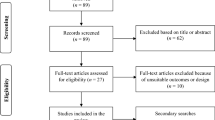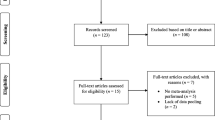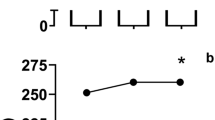Abstract
Summary
This study describes the impact of bicarbonate treatment for 3 months on net acid excretion (NAE), nitrogen excretion, and muscle performance in older men and women. Bicarbonate reduced NAE, and the decrement was associated with a decrease in nitrogen excretion. Treatment also improved muscle power and endurance in the women.
Introduction
Bicarbonate enhances muscle performance during strenuous exercise, but its effect on performance during normal activity in older subjects is unknown.
Methods
In this trial, healthy subjects age 50 and older were randomized to 67.5 mmol of bicarbonate or to no bicarbonate daily for 3 months. Changes in lower-extremity muscle power, endurance, urinary nitrogen, and NAE were compared across treatment groups in the 162 participants included in the analyses.
Results
In the men and the women, bicarbonate was well tolerated, and as expected, it significantly decreased NAE. The change in NAE correlated with change in nitrogen excretion in women (r = 0.32, P = 0.002) with a similar trend in men (r = 0.23, P = 0.052). In the women, bicarbonate increased double leg press power at 70% one repetition maximum by 13% (P = 0.003) compared with no bicarbonate and improved other performance measures. Treatment with bicarbonate had no significant effect on muscle performance in the men.
Conclusions
Ingestion of bicarbonate decreased nitrogen excretion and improved muscle performance in healthy postmenopausal women. The bicarbonate-induced decline in NAE was associated with reduced nitrogen excretion in both men and women. These findings suggest that bicarbonate merits further evaluation as a safe, low-cost intervention that may attenuate age-related loss of muscle performance and mass in the elderly.




Similar content being viewed by others
References
Tinetti ME, Speechley M, Ginter SF (1988) Risk factors for falls among elderly persons living in the community. N Engl J Med 319:1701–1707
Campbell AJ, Robertson MC, Gardner MM, Norton RN, Tilyard MW, Buchner DM (1997) Randomised controlled trial of a general practice programme of home-based exercise to prevent falls in elderly women. BMJ 315:1065–1069
Goodpaster BH, Park SW, Harris TB, Kritchevsky SB, Nevitt M, Schwartz AV, Simonsick EM, Tylavsky FA, Visser M, Newman AB (2006) The loss of skeletal muscle strength, mass, and quality in older adults: the health, aging, and body composition study. J Gerontol A Biol Sci Med Sci 61:1059–1064
Metter EJ, Conwit R, Tobin J, Fozard JL (1997) Age-associated loss of power and strength in the upper extremities in women and men. J Gerontol A Biol Sci Med Sci 52:B267–B276
Foldvari M, Clark M, Laviolette LC, Bernstein MA, Kaliton D, Castaneda C, Pu CT, Hausdorff JM, Fielding RA, Singh MA (2000) Association of muscle power with functional status in community-dwelling elderly women. J Gerontol A Biol Sci Med Sci 55:M192–M199
Bassey EJ, Fiatarone MA, O'Neill EF, Kelly M, Evans WJ, Lipsitz LA (1992) Leg extensor power and functional performance in very old men and women. Clin Sci (Lond) 82:321–327
Suzuki T, Bean JF, Fielding RA (2001) Muscle power of the ankle flexors predicts functional performance in community-dwelling older women. J Am Geriatr Soc 49:1161–1167
Kurtz I, Maher T, Hulter HN, Schambelan M, Sebastian A (1983) Effect of diet on plasma acid-base composition in normal humans. Kidney Int 24:670–680
Frassetto LA, Morris RC Jr, Sebastian A (1996) Effect of age on blood acid-base composition in adult humans: role of age-related renal functional decline. Am J Physiol 271:t-22
Douroudos II, Fatouros IG, Gourgoulis V, Jamurtas AZ, Tsitsios T, Hatzinikolaou A, Margonis K, Mavromatidis K, Taxildaris K (2006) Dose-related effects of prolonged NaHCO3 ingestion during high-intensity exercise. Med Sci Sports Exerc 38:1746–1753
Maurer M, Riesen W, Muser J, Hulter HN, Krapf R (2003) Neutralization of Western diet inhibits bone resorption independently of K intake and reduces cortisol secretion in humans. Am J Physiol - Renal 284:F32–F40
Green J, Kleeman CR (1991) Role of bone in regulation of systemic acid-base balance. Kidney Int 39:9–26
May RC, Kelly RA, Mitch WE (1986) Metabolic acidosis stimulates protein degradation in rat muscle by a glucocorticoid-dependent mechanism. J Clin Invest 77:614–621
Mitch WE, Price SR, May RC, Jurkovitz C, England BK (1994) Metabolic consequences of uremia: extending the concept of adaptive responses to protein metabolism. Am J Kidney Dis 23:224–228
Edge J, Bishop D, Goodman C (2006) The effects of training intensity on muscle buffer capacity in females. Eur J Appl Physiol 96:97–105
Dawson-Hughes B, Harris SS, Palermo NJ, Castaneda-Sceppa C, Rasmussen HM, Dallal GE (2009) Treatment with potassium bicarbonate lowers calcium excretion and bone resorption in older men and women. J Clin Endocrinol Metab 94:96–102
Washburn RA, Smith KW, Jette AM, Janney CA (1993) The physical activity scale for the elderly (PASE): development and evaluation. J Clin Epidemiol 46:153–162
Fielding RA, LeBrasseur NK, Cuoco A, Bean J, Mizer K, Fiatarone Singh MA (2002) High-velocity resistance training increases skeletal muscle peak power in older women. J Am Geriatr Soc 50:655–662
American College of Sports M, Roitman J (2000) Guidelines for exercise testing and prescription. Lippincott, Philadelphia
Frontera WR, Hughes VA, Dallal GE, Evans WJ (1993) Reliability of isokinetic muscle strength testing in 45- to 78-year-old men and women. Arch Phys Med Rehabil 74:1181–1185
Jorgensen K (1957) Titrimetric determination of the net excretion of acid/base in urine. Scand J Clin Lab Invest 9:281–291
Chan JC (1972) The rapid determination of urinary titratable acid and ammonium and evaluation of freezing as a method of preservation. Clin Biochem 5:94–98
Pfeifer M, Begerow B, Minne HW, Abrams C, Nachtigall D, Hansen C (2000) Effects of a short-term vitamin D and calcium supplementation on body sway and secondary hyperparathyroidism in elderly women. J Bone Miner Res 15:1113–1118
Bischoff HA, Stahelin HB, Dick W, Akos R, Knecht M, Salis C, Nebiker M, Theiler R, Pfeifer M, Begerow B, Lew RA, Conzelmann M (2003) Effects of vitamin D and calcium supplementation on falls: a randomized controlled trial. J Bone Miner Res 18:343–351
Sato Y, Iwamoto J, Kanoko T, Satoh K (2005) Amelioration of osteoporosis and hypovitaminosis D by sunlight exposure in hospitalized, elderly women with Alzheimer's disease: a randomized controlled trial. J Bone Miner Res 20:1327–1333
Reid KF, Callahan D, Carabello R, Phillips E, Frontera WR, Fielding RA (2008) Lower extremity power training in elderly subjects with mobility limitations: a randomized controlled trial. Aging Clin Exp Res 20
Earles DR, Judge JO, Gunnarsson OT (2001) Velocity training induces power-specific adaptations in highly functioning older adults. Arch Phys Med Rehabil 82:872–878
Dhesi JK, Bearne LM, Moniz C, Hurley MV, Jackson SH, Swift CG, Allain TJ (2002) Neuromuscular and psychomotor function in elderly subjects who fall and the relationship with vitamin D status. J Bone Miner Res 17:891–897
Mauras N, Beaufrere B (1995) Recombinant human insulin-like growth factor-I enhances whole body protein anabolism and significantly diminishes the protein catabolic effects of prednisone in humans without a diabetogenic effect. J Clin Endocrinol Metab 80:869–874
Ballmer PE, McNurlan MA, Hulter HN, Anderson SE, Garlick PJ, Krapf R (1995) Chronic metabolic acidosis decreases albumin synthesis and induces negative nitrogen balance in humans. J Clin Invest 95:39–45
Sebastian A, Frassetto LA, Sellmeyer DE, Merriam RL, Morris RC Jr (2002) Estimation of the net acid load of the diet of ancestral preagricultural Homo sapiens and their hominid ancestors. Am J Clin Nutr 76:1308–1316
Giannoulis MG, Sonksen PH, Umpleby M, Breen L, Pentecost C, Whyte M, McMillan CV, Bradley C, Martin FC (2006) The effects of growth hormone and/or testosterone in healthy elderly men: a randomized controlled trial. J Clin Endocrinol Metab 91:477–484
Bischoff-Ferrari HA, Orav EJ, Dawson-Hughes B (2008) Additive benefit of higher testosterone levels and vitamin D plus calcium supplementation in regard to fall risk reduction among older men and women. Osteoporos Int 19:1307–1314
Frassetto L, Morris RC Jr, Sebastian A (1997) Potassium bicarbonate reduces urinary nitrogen excretion in postmenopausal women. J Clin Endocrinol Metabol 82:254–259
Baker AJ, Brandes R, Weiner MW (1995) Effects of intracellular acidosis on Ca2+ activation, contraction, and relaxation of frog skeletal muscle. Am J Physiol 268:C55–C63
Sutton JR, Jones NL, Toews CJ (1981) Effect of PH on muscle glycolysis during exercise. Clin Sci (Lond) 61:331–338
Hirche HJ, Hombach V, Langohr HD, Wacker U, Busse J (1975) Lactic acid permeation rate in working gastrocnemii of dogs during metabolic alkalosis and acidosis. Pflugers Arch 356:209–222
Mainwood GW, Worsley-Brown P (1975) The effects of extracellular pH and buffer concentration on the efflux of lactate from frog sartorius muscle. J Physiol 250:1–22
Williams B, Layward E, Walls J (1991) Skeletal muscle degradation and nitrogen wasting in rats with chronic metabolic acidosis. Clin Sci 80:457–462
Guder WG, Haussinger D, Gerok W (1987) Renal and hepatic nitrogen metabolism in systemic acid base regulation. J Clin Chem Clin Biochem 25:457–466
Cersosimo E, Williams PE, Radosevich PM, Hoxworth BT, Lacy WW, Abumrad NN (1986) Role of glutamine in adaptations in nitrogen metabolism during fasting. Am J Physiol 250:E622–E628
Acknowledgments
We thank Dr. Catherine Gordon of Children's Hospital in Boston for being the safety monitor of this study, the staffs of the Metabolic Research Unit and the Nutrition Evaluation Laboratory, and the study participants for their valuable contributions.
The author's responsibilities were: B. Dawson-Hughes, C. Castaneda-Sceppa, S.S. Harris, and G.E. Dallal designed the study and B. Dawson-Hughes, C. Castaneda-Sceppa, S.S. Harris, N. Palermo, G. Cloutier, and L. Ceglia contributed to data collection and processing. All authors contributed to data interpretation and manuscript writing.
Conflicts of interest
None.
Author information
Authors and Affiliations
Corresponding author
Additional information
This project was supported by Grant Number 1 RO1AR052322-01A1 from NIAMS and also received support from the US Department of Agriculture, Agricultural Research Service, under agreement No. 58-1950-7-707. Any opinions, findings, conclusion, or recommendations expressed in this publication are those of the author(s) and do not necessarily reflect the view of the US Department of Agriculture.
Rights and permissions
About this article
Cite this article
Dawson-Hughes, B., Castaneda-Sceppa, C., Harris, S.S. et al. Impact of supplementation with bicarbonate on lower-extremity muscle performance in older men and women. Osteoporos Int 21, 1171–1179 (2010). https://doi.org/10.1007/s00198-009-1049-0
Received:
Accepted:
Published:
Issue Date:
DOI: https://doi.org/10.1007/s00198-009-1049-0




